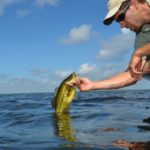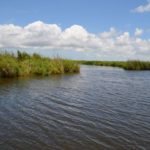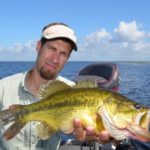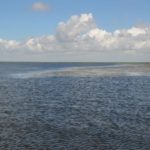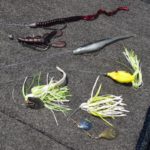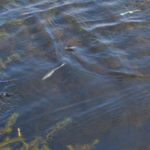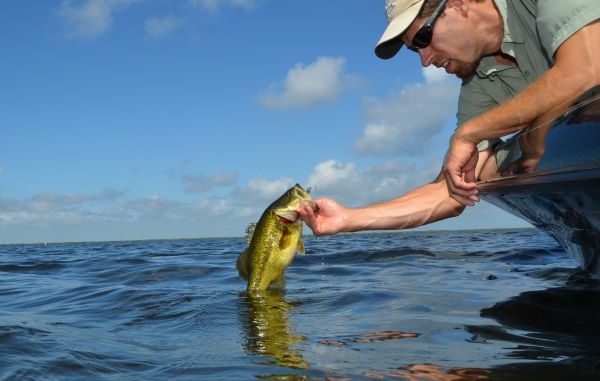
The Caernarvon Freshwater Diversion did more than introduce fresh water to the marshes southeast of New Orleans. It also created bass-fishing nirvana
We’ve come a long way since virtually everyone in Southeast Louisiana used the term “green trout” to refer to largemouth bass. One of Louisiana’s first conservation laws on the books was for the protection of New Orleans green trout populations.
Nothing has done more to create the current Southeast Louisiana “bass buzz” than the creation of the Caernarvon Freshwater Diversion Project in 1991.
The project was designed to introduce up to 8,000 cubic feet per second of fresh water from the Mississippi River into the low-lying, primarily brackish wetlands lying east of the great river.
The project produced almost immediate environmental impacts. One of them was the creation of what is now, arguably, one of the five best largemouth bass fishing holes in the state.
Every superlative adjective in the book has been used to describe the fishery. The hype is so strong that a novice to the area can believe that all one has to do is show up, drop a hook and catch a limit — one, two, three.
But, as always in fishing, reality displaces hype when the boat hits the water. Caernarvon can be great, but it can also be a temperamental mistress.
The first thing that hits you is its size.
Unlike hotspots like Caney Lake (5,000 acres) or Poverty Point (2,700 acres), Caernarvon is huge. The official line from the Louisiana Department of Natural Resources is that 16,000 acres are directly impacted and 77,000 acres are “benefitted” (read indirectly impacted) by the diversion project.
And it all seems to look alike to the uninitiated. Little of the water is deeper than 5 feet. The bottoms are all soft mud. There are virtually no trees.
Combined, this means that traditional structure fishing is out.
Meet 33-year old Kevin Schilling, one of the anglers who has mastered fishing Caernarvon.
The ride to the big freshwater marsh was a blisteringly short one in his Ranger bass boat. The bugs hit the lens of the ATV goggles he gave to me like .22 slugs.
First stop was Lake Lery, the biggest water body in the Caernarvon outfall area.
“I always start here, since I have to cross it anyway,” he explained.
He stopped within trolling-motor distance of a weed bed.
“The grass,” he went on, “gives a place for the (bass) to hide and a place for bream and crawfish.
“Half the fish you cut open have crawfish in them.”
The morning’s tutorial, which had just begun, would revolve around two subjects: where to fish and what to throw at the picky green fish.
He began casting a topwater frog when he neared the lake’s grass line. The sun was just peeping over the horizon.
“Everybody likes that early morning topwater bite,” Schilling grinned. “Summertime (late May through September) marsh fishing is all about the grass. We don’t have the wood that other areas do.
“I’m looking for grass points. Bass will congregate on either side of a point. The points affect water currents, which are driven by tide or wind.”
The presence of vegetation is vital to success he said.
“If you are devoid of grass, you are devoid of bass,” Schilling chuckled, obviously pleased with his rhyming.
The grass points Schilling referred to are small or large extensions of aquatic plants that, for whatever reason, jut into open water. The lakes of the area — Lery, Grand, Spanish and Lost lakes, as well as others — are all fringed with grass early in the summer.
By late summer, many are so choked with growth that only the lakes’ centers and boat lanes are open.
The aquatic plants that make up the “grass” are milfoil (fanwort in the aquarium trade) and coontail (hornwort to aquarists).
In a half hour, Schilling put up his frog rod for good without having triggered a single blow-up. He shifted to alternately casting a Zoom Fluke or a Culprit plastic worm.
“The other thing that is significant is all the drains that come out of the marsh — the drain itself and the area 50 to 100 yards on either side of a drain, depending on current direction, will hold bass.”
Drains, by Schilling’s definition, cover a lot of ground, or more appropriately water. They can be old, man-made canals, natural openings into the marsh or recent “blow-outs” that connect interior marsh ponds with lakes and bayous.
Even lanes of open water that run through grass beds fall generally within his definition.
Cut-like drains that connect interior marsh pond with larger water bodies, bayous or canals come in two flavors and are fished differently.
With deeper drains, Schilling uses his trolling motor to “follow the fish inside,” to use his words.
Shallow drains that open into flats that are too shallow to troll into are typically not productive on a rising tide. On falling tides, the outsides of both types of cuts are fished.
The Zoom Fluke produced a lot of hits. He fished the jerk bait with rapid twitches to irritate the fish into striking before they got a good look at it in the near crystal-clear water.
But the fish were picky. Lots of them ran up to the bait (visible in the clear water) and then backed down.
“Gaa — come on fish; eat,” Schilling whined plaintively.
He triggered a lot of strikes, but most of them were short.
In response, Schilling delivered smashing gorilla hook sets.
“Anything under a half pound comes out of the water,” he grinned.
It was almost comical to watch. With a missed strike, the lure would go rocketing by the angler’s head. Often the slack line would wrap around his head and body.
“Oh that sucks — aargh,” he growled one time, as he unwound himself from a particularly masterful body wrap.
Kevin Schilling has five go-to baits he said are all that are necessary to fish Caernarvon during the warm months: topwater frogs, Zoom Flukes, soft-plastic crawfish baits, rubber worms, and spinnerbaits and ChatterBaits.
Here are his thoughts about each approach:
Topwater frogs
Any brand of topwater frog will work, as long as it is weedless, Schilling said.
The one he had on his rod was the cheapest one sold at Academy Sporting Goods.
“Frogs get expensive real quick,” he explained, adding, “I don’t believe color matters, either.”
Topwater frogs are an early morning bait on sunny days. On drizzly, cloudy days he fishes them all day long.
Soft-plastic Crawfish
Schilling is not particular about the brand of soft-plastic crawfish he uses. This day he used a Zoom Speed Craw.
Soft-plastic crawfish are always rigged weedless, Texas style, with a 3/16-ounce lead or 1/2-ounce tungsten bullet weight on the line ahead of the lure.
Favored colors are darker reds or occasionally browns.
Soft-plastic crawfish are specialty lures, used when the area weeds up with dense plant growth. Schilling looks for holes in the vegetation and pitches the lure into them.
He uses a specialized rig for this fishing: a 7-foot Abu Garcia Veritas flipping rod with an Abu Garcia Revo S baitcasting reel spooled with 80-pound-test braided line. He favors the reel for its low profile, which he said fits his hand for pitching.
Zoom Fluke
Schilling is brand-specific with this lure, but not particular about color.
“Anything that resembles baitfish, with silver or white sides, is fine,” he stated. “The color of the back doesn’t make any difference.”
The lure is fished weightless, with a 3/0 offset hook poked through the nose of the lure and then buried back into its body, effectively making it weedless.
It is fished with a side-to-side skitter at the water’s surface.
“I like to see the bite,” he smiled, “but it can be fished subsurface rigged Texas style with a 1/8-ounce bullet weight. But I don’t want it to dive bomb.”
Rubber Worm
Schilling’s favorite choice for this soft-plastic lure is a 7 1/2-inch Culprit Worm. Favored colors are red shad (which he likes best), june bug, voodoo or green pumpkin.
He fishes worms Texas-style with 1/8- or 3/16-ounce (no more, he cautioned) bullet weights. His preference is for the lighter weight, but he will go to the larger weight in very windy conditions.
The lure is fished with a steady bouncing retrieve that he works quickly to cover a lot of area.
“I’m looking for aggressively feeding fish, not lethargic fish,” he explained. “There are too many fish out here for that.”
He admitted he will retrieve the bait more slowly if the spot holds a lot of fish.
He called the worm an “all-day bait” because it works under many conditions. He added that the average size bass caught with the worm is slightly smaller than those caught with topwater frogs or flukes.
Spinnerbaits/ChatterBaits
Schilling lumps these two lures together because they are fished similarly with a similar purpose. They are designed to cover a lot of water.
When biting bass are found with the lures, he will slow down and fish the area with worms or flukes.
His favored spinnerbait is a 1/4-ounce Humdinger with Colorado blades. ChatterBaits are 3/8-ounce. Skirt colors are white, chartreuse or a combination of the two.
A constant retrieve with a fast reel is used for both lures.
